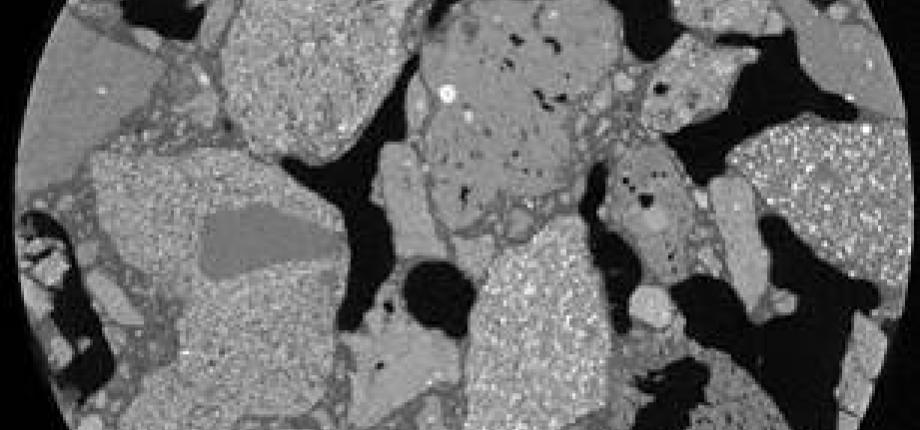Master Year 2 in Materials Science for Sustainable Construction

| Year | Master Year 2 |
| Program | Civil ENgineering |
| ECTS Credits | 60 |
| Language | English |
| Orientation | Research |
| Location | ENPC, Champs-sur-Marne Campus |
| Course duration | 12 months, full time |
| Course start | September |
| Degree awarded | Master |
WHY ENROLL IN THIS PROGRAM?
Asset n° 1
A multidisciplinary program focused on sustainable and innovative materials.
Asset n°2
Advanced training in physics, chemistry, mechanics, modeling and environmental assessment.
Asset n°3
Careers in research and development of sustainable materials.
The emergence of sustainable development has significantly raised the standards for modern materials. They must be insulating and lightweight to reduce raw material and energy consumption, easy to manufacture and implement, durable and resilient, and finally recyclable and suitable for valorization at end-of-life. Addressing these multifaceted constraints introduces novel challenges that demand interdisciplinary approaches and the emergence of new academic fields. The required solutions are therefore diverse, and their development represents a scientific, technical, and industrial challenge.
This Master’s program provides the scientific foundations necessary for a multidisciplinary, multiscale understanding of material behavior, optimization of their fabrication, functional properties, and durability under defined environmental conditions. Structured into thematic modules—covering physics, mechanics, chemistry, and numerical simulation—and complemented by modules addressing environmental and energy challenges, this program prepares students for careers in research and development within leading industries and research laboratories.
Objectives
- A deep understanding of the fundamental principles governing material behavior (mechanics, physics, chemistry), and the ability to connect a material’s microstructure to its macroscopic properties.
- Analytical skills to evaluate intrinsic material properties—mechanical, hydro-mechanical, thermal, and rheological.
- Expertise in advanced characterization techniques, including imaging, NMR, rheometry, and mechanical testing.
- Ability to assess and quantify the environmental footprint of materials across their lifecycle—from production and application to recycling and end-of-life solutions.
This Master’s program prepares students for careers in research and development within both companies and leading public research institutions, specializing in materials science, innovation, and construction. Pursuing a PhD after the Master’s is strongly encouraged—67% of our graduates continue go on to doctoral studies.
- Examples of graduate employers: Holcim, Michelin, Électricité de France, Saint-Gobain, Bouygues, CSTB, and more.
- Examples of universities where graduates have pursued PhDs: Institut Polytechnique de Paris, EPFL, ESPCI, École Normale Supérieure Paris-Saclay, Imperial College London, Harvard University, ETH Zurich, and others.
| Course title | ECTS / Language |
| Imaging of random media | 2,5 / English |
| Nuclear Magnetic Resonance in material sciences | 2,5 / English |
| Physical chemistry of building materials | 2,5 / English |
| Sustainable construction | 4 / English |
| Soft matter | 3 / English |
| Complex fluids | 3 / English |
| Mechanics and physics of porous solids | 3,5 / English |
| Bio-based construction materials | 3 / English |
| Fluids and grains rheology and mixing | 3 / English |
| Building with earth | 3 / English |
| Course title | ECTS / Language |
| Professional or research internship (4 to 6 months) | 30 / English or French |
Admission requirements
Academic prerequisites
- Master or completion of 60 ECTS within a program in Physics, Chemistry, Mechanics, Materials Science and Engineering, or Civil Engineering.
- Degree corresponding to 240 ECTS in Physics, Chemistry, Mechanics, Materials Science and Engineering, or Civil Engineering.
- Engineering or Master’s degree in Physics, Chemistry, Mechanics, Materials Science and Engineering, or Civil Engineering.
Language prerequisites
- English [B1 Common European Framework of Reference/ TOEFL iBT > 72 / TOEFL ITP > 550]
How to apply
Applications can be submitted exclusively online. You will need to provide the following documents:
- Transcript
- Two academic references (added online directly by your referees)
- CV/resume
- Statement of purpose
Fees and scholarships
Registration fees are available here
Find out more about scholarships
Please note that fees and scholarships may change for the following year.
Applications and admission dates
The SMCD master's program has indeed been an enlightening journey, characterized by a flexible, diverse, and multidisciplinary curriculum. Delving into various approaches like physics, chemistry, mechanics, and simulations to comprehend material behavior has significantly expanded my knowledge, particularly in engineering disciplines.
Learning from experienced and prominent professors has been a valuable asset, allowing me to draw from their rich expertise.
This program has not only equipped me with a profound understanding of sustainable materials but has also provided a unique opportunity to start my career in research in the domain of earthen materials.
The SMCD masters program was a determining factor in the following steps of my career. It may have been due to the passion the professors showed for their specific subjects or perhaps the level of comprehension being passed down to me as a student, perhaps even both.
Through conclusion of the SMCD courses, I was more than confident that I had the tools and the motivation to pursue a PhD. However, more than just knowledge and passion for science, the course also opened many doors to continue working with material science in the industry or in academia, thanks to its renown and the contact with the teachers.
I did not need to search for a PhD or a role as a materials engineer, I had the opportunity of choosing one.
The emergence of sustainable development has significantly raised the standards for modern materials. They must be insulating and lightweight to reduce raw material and energy consumption, easy to manufacture and implement, durable and resilient, and finally recyclable and suitable for valorization at end-of-life. Addressing these multifaceted constraints introduces novel challenges that demand interdisciplinary approaches and the emergence of new academic fields. The required solutions are therefore diverse, and their development represents a scientific, technical, and industrial challenge.
This Master’s program provides the scientific foundations necessary for a multidisciplinary, multiscale understanding of material behavior, optimization of their fabrication, functional properties, and durability under defined environmental conditions. Structured into thematic modules—covering physics, mechanics, chemistry, and numerical simulation—and complemented by modules addressing environmental and energy challenges, this program prepares students for careers in research and development within leading industries and research laboratories.
Objectives
- A deep understanding of the fundamental principles governing material behavior (mechanics, physics, chemistry), and the ability to connect a material’s microstructure to its macroscopic properties.
- Analytical skills to evaluate intrinsic material properties—mechanical, hydro-mechanical, thermal, and rheological.
- Expertise in advanced characterization techniques, including imaging, NMR, rheometry, and mechanical testing.
- Ability to assess and quantify the environmental footprint of materials across their lifecycle—from production and application to recycling and end-of-life solutions.
This Master’s program prepares students for careers in research and development within both companies and leading public research institutions, specializing in materials science, innovation, and construction. Pursuing a PhD after the Master’s is strongly encouraged—67% of our graduates continue go on to doctoral studies.
- Examples of graduate employers: Holcim, Michelin, Électricité de France, Saint-Gobain, Bouygues, CSTB, and more.
- Examples of universities where graduates have pursued PhDs: Institut Polytechnique de Paris, EPFL, ESPCI, École Normale Supérieure Paris-Saclay, Imperial College London, Harvard University, ETH Zurich, and others.
| Course title | ECTS / Language |
| Imaging of random media | 2,5 / English |
| Nuclear Magnetic Resonance in material sciences | 2,5 / English |
| Physical chemistry of building materials | 2,5 / English |
| Sustainable construction | 4 / English |
| Soft matter | 3 / English |
| Complex fluids | 3 / English |
| Mechanics and physics of porous solids | 3,5 / English |
| Bio-based construction materials | 3 / English |
| Fluids and grains rheology and mixing | 3 / English |
| Building with earth | 3 / English |
| Course title | ECTS / Language |
| Professional or research internship (4 to 6 months) | 30 / English or French |
Admission requirements
Academic prerequisites
- Master or completion of 60 ECTS within a program in Physics, Chemistry, Mechanics, Materials Science and Engineering, or Civil Engineering.
- Degree corresponding to 240 ECTS in Physics, Chemistry, Mechanics, Materials Science and Engineering, or Civil Engineering.
- Engineering or Master’s degree in Physics, Chemistry, Mechanics, Materials Science and Engineering, or Civil Engineering.
Language prerequisites
- English [B1 Common European Framework of Reference/ TOEFL iBT > 72 / TOEFL ITP > 550]
How to apply
Applications can be submitted exclusively online. You will need to provide the following documents:
- Transcript
- Two academic references (added online directly by your referees)
- CV/resume
- Statement of purpose
Fees and scholarships
Registration fees are available here
Find out more about scholarships
Please note that fees and scholarships may change for the following year.
Applications and admission dates
The SMCD master's program has indeed been an enlightening journey, characterized by a flexible, diverse, and multidisciplinary curriculum. Delving into various approaches like physics, chemistry, mechanics, and simulations to comprehend material behavior has significantly expanded my knowledge, particularly in engineering disciplines.
Learning from experienced and prominent professors has been a valuable asset, allowing me to draw from their rich expertise.
This program has not only equipped me with a profound understanding of sustainable materials but has also provided a unique opportunity to start my career in research in the domain of earthen materials.
The SMCD masters program was a determining factor in the following steps of my career. It may have been due to the passion the professors showed for their specific subjects or perhaps the level of comprehension being passed down to me as a student, perhaps even both.
Through conclusion of the SMCD courses, I was more than confident that I had the tools and the motivation to pursue a PhD. However, more than just knowledge and passion for science, the course also opened many doors to continue working with material science in the industry or in academia, thanks to its renown and the contact with the teachers.
I did not need to search for a PhD or a role as a materials engineer, I had the opportunity of choosing one.














